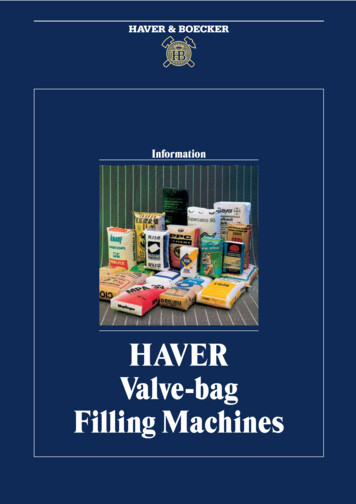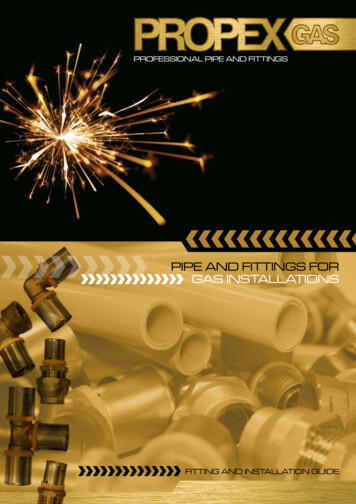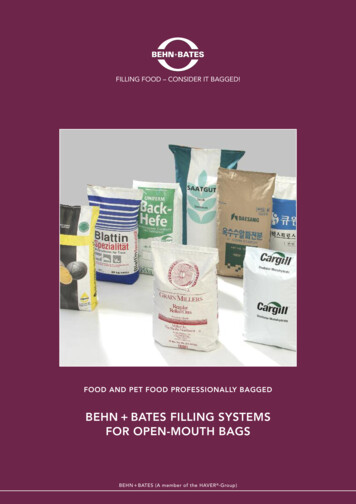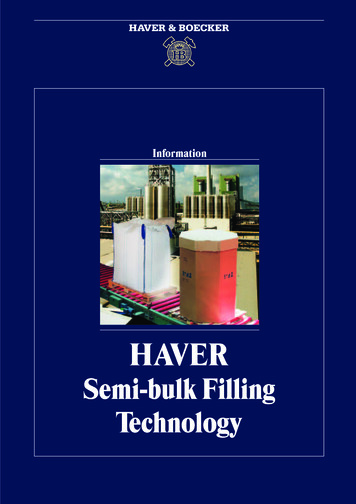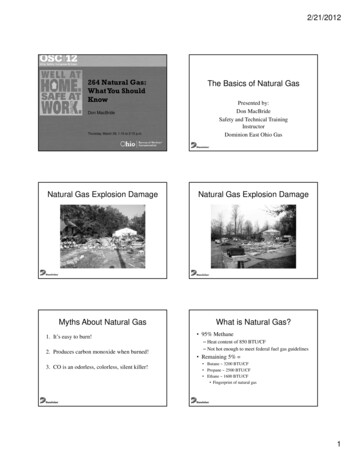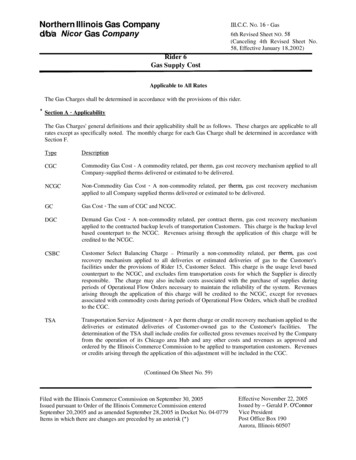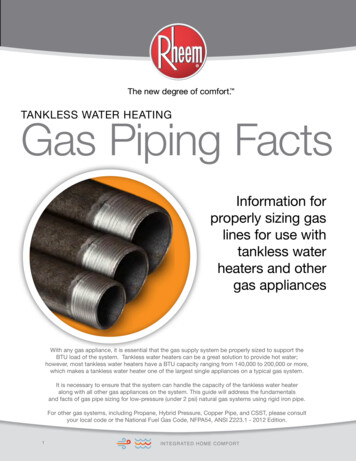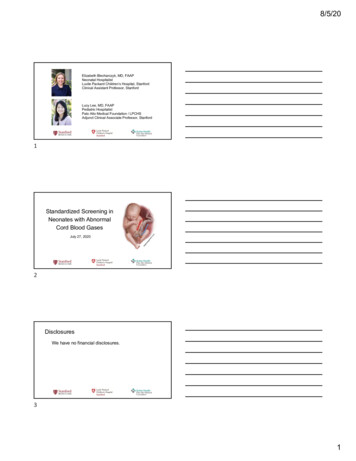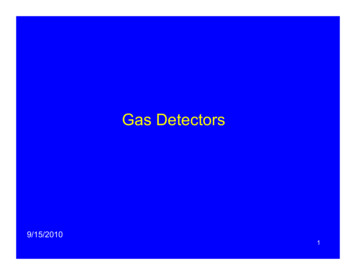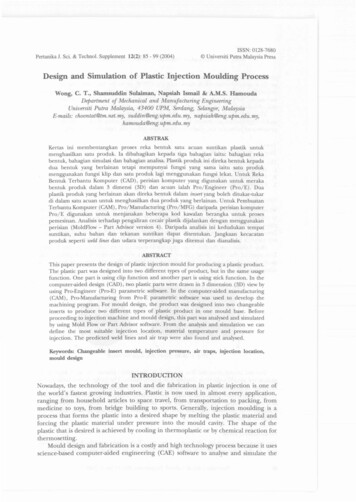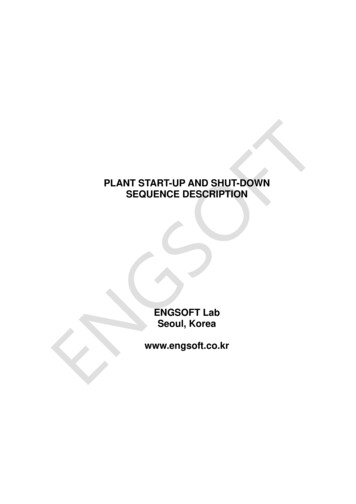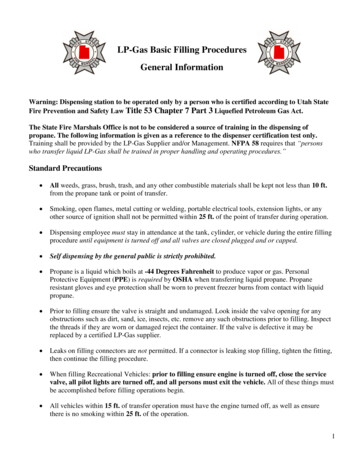
Transcription
LP-Gas Basic Filling ProceduresGeneral InformationWarning: Dispensing station to be operated only by a person who is certified according to Utah StateFire Prevention and Safety Law Title 53 Chapter 7 Part 3 Liquefied Petroleum Gas Act.The State Fire Marshals Office is not to be considered a source of training in the dispensing ofpropane. The following information is given as a reference to the dispenser certification test only.Training shall be provided by the LP-Gas Supplier and/or Management. NFPA 58 requires that “personswho transfer liquid LP-Gas shall be trained in proper handling and operating procedures.”Standard Precautions All weeds, grass, brush, trash, and any other combustible materials shall be kept not less than 10 ft.from the propane tank or point of transfer. Smoking, open flames, metal cutting or welding, portable electrical tools, extension lights, or anyother source of ignition shall not be permitted within 25 ft. of the point of transfer during operation. Dispensing employee must stay in attendance at the tank, cylinder, or vehicle during the entire fillingprocedure until equipment is turned off and all valves are closed plugged and or capped. Self dispensing by the general public is strictly prohibited. Propane is a liquid which boils at -44 Degrees Fahrenheit to produce vapor or gas. PersonalProtective Equipment (PPE) is required by OSHA when transferring liquid propane. Propaneresistant gloves and eye protection shall be worn to prevent freezer burns from contact with liquidpropane. Prior to filling ensure the valve is straight and undamaged. Look inside the valve opening for anyobstructions such as dirt, sand, ice, insects, etc. remove any such obstructions prior to filling. Inspectthe threads if they are worn or damaged reject the container. If the valve is defective it may bereplaced by a certified LP-Gas supplier. Leaks on filling connectors are not permitted. If a connector is leaking stop filling, tighten the fitting,then continue the filling procedure. When filling Recreational Vehicles: prior to filling ensure engine is turned off, close the servicevalve, all pilot lights are turned off, and all persons must exit the vehicle. All of these things mustbe accomplished before filling operations begin. All vehicles within 15 ft. of transfer operation must have the engine turned off, as well as ensurethere is no smoking within 25 ft. of the operation.1
LP-Gas pressure increases with temperature. To allow for expansion, propane containers are to befilled only to 80% of their capacity. Never overfill cylinders. Never round up the meter after thecylinder is full, this will overfill the container. It is unlawful for a customer to ask to or overfill acontainer. Fill cylinders by using the fixed liquid level gauge. If a fixed liquid level gauge is not installed in thecontainer, the container must be filled by weight (contact LP supplier for instructions and equipment).Never use a float or empty/full type gauge during the filling procedure. Immediately stop filling when white mist or fog (liquid) starts to spray out of the fixed liquid levelgauge. Shut off the hose end, close the service valve, and disconnect the connector. After filling applysoap solution or approved leak detector to test for leaks. To prevent an accidental leak and prior to transportation; valve outlets on all DOT & ICC cylinderswith a capacity of 50 lbs. or more without an OPD valve require a POL Plug or protective cap(many screw onto the cylinder itself, make sure this is firmly secured before transporting). OPDvalves do not require a plug as this may open the seal on the valve and cause a leak. Instead use acap or dust cover. Cylinders shall be transported in the upright position unless otherwise indicated on the cylinder byarrows or other marking. (Horizontal cylinders) In its natural state LPG is colorless and odorless. To increase the likelihood of detection, ethylmercaptan, a sulfur-based compound is added to the gas at the time of production. This gives theLiquefied Petroleum Gas a rotten egg smell. If the ethyl-mercaptan (rotten egg) smell is detected prior to filling, care should be taken to check forpossible leaks in the cylinder, dispensing hose, piping, valves, and tank. If a leak is detected the LPdistributor shall be contacted to have it repaired before dispensing. Purging: to get rid of something undesirable, impure, or imperfect. Purging is required to removeair, methanol, and water from the cylinder. All new and repaired cylinders must be purged prior tofilling and placing in service. All propane cylinders are equipped with at least one spring-loaded pressure relief valve, designed toopen when pressures inside the contained reach the pressure setting. Overfilling and hightemperatures may cause this valve to open. Once the container has reached the proper pressure thevalve will close. If propane is released into the air it quickly vaporizes, expanding at 270 times itsoriginal volume. Meaning 1 gallon of liquid released 270 gallons of vapor which in turn makesover 10,000 gallons of flammable fuel to air mixture. If a cylinder should relieve this would cause aserious situation. Do not overfill containers.Cylinder Markings Cylinders approved for use with LP-gas will have one of the following specification numbersfollowing the DOT stamping: 4B-240, 4BA-240, 4B-300, 4BW-240, 4E-240, and ICC 26-300. The“240” in the DOT 4B-240 designates the service working pressure of the cylinder. Only cylinderswith one of these markings may be used for LP-gas.2
Cylinder Requalification Department of Transportation regulations require that all DOT or ICC cylinders be inspected and requalified within 12 years of the date of manufacture and every 5 years thereafter. This inspection istypically done by a qualified technician when your cylinder is refilled. For information about cylinderinspection and requalification consult your propane gas dealer. Your cylinder should also bear a decal which identifies the contents as a flammable gas by name andinternational I.D. number (UN 1075). Other cylinder warning labels available from your propane gasdealer are useful for future reference. Filling a DOT propane gas cylinder that has not been properlyinspected and qualified violates federal law.Handling Propane Cylinders Safely Propane gas cylinders must be transported so the relief valve communicates with the vapor space atall times. For that reason, you should never transport a cylinder lying on its side unless it is designedfor horizontal use. When transporting or storing disconnected cylinders, the container outlets must be plugged, orcapped. This will keep gas from escaping and prevent foreign material from entering the cylindershould the valve be opened accidentally. Never use, store, or transport full or empty cylinders in thepassenger space or living area of your vehicle, RV, or camper. Never store a cylinder inside a house, building, or a garage. Spare cylinders should be stored outdoorsand up off the ground on a non-combustible base. Any cylinder that is damaged shows signs ofcorrosion, has been exposed to fire, or appears to be leaking gas should be removed from serviceimmediately. Store defective cylinders in a safe, outdoor location. Then as soon as possible, havethem repaired or disposed of by a qualified service technician. New cylinders must be properly purged of air by a qualified person prior to filling for the first time.This is because air left in the cylinder will affect how your appliance works. The presence of air canalso diminish the odorant level in the container and cause excessive pressures. Once a cylinder hasbeen properly purged of air, keep the cylinder valve closed, except when connected for use. DOT cylinders are filled by weight or fixed liquid level gauge to insure against overfilling. Be sure tohave your cylinder filled by a qualified individual, and if filled by fixed level gauge, have the weightof the cylinder checked occasionally to assure that the tube in the fixed gauge is properly located andgiving an accurate measurement. Only personnel trained in the proper filling procedures of DOTcylinders should engage in this activity.3
Visual Cylinder InspectionAll cylinders will undergo a simple visual inspection prior to being filled. This exterior inspection isperformed on all bottles regardless of size or type. The bottle filler is looking for the following things:1) Damage to the cylinders exterior including dents, bulges, cuts, or cracks on the container's surface orcontaining a weld.a) Any damage containing a weld will be cause for failure and shall not be filled.2) Excessive rust or pitting on the cylinder, particularly on the bottom of the bottle.3) Absence and condition of a cylinder foot ring, cylinder collar, or valve cover.4) Evidence of physical abuse, fire or heat damage.5) Leaks, leaking or defective valve.6) The date the cylinder was manufactured or last recertified. Cylinders that are out of qualification mustNOT be refilled.a) All DOT cylinders must be recertified 12 years after manufacture date and every 5 years there after.i) Date of Manufacture shall be indicated by a month and a year (01-04). Recertification date will beindicated in one of 2 ways: month and year followed by an “E” (05-08 E) or A#7) Required cylinder markings and readability.05 08E (month/year)8) OPD valve (if required).## (DOT issued #)9) Discoloration of the valve (ammonia contamination).If the bottle filler is unable to fill the bottle because it fails the visual inspection, it is strictly for safety,regulatory compliance and in the consumers’ best interest.4
Overfilling Protection Device- OPDAs of April 1, 2002, cylinders without an OPD cannot be refilled!Beginning October 1, 1998, all newly manufactured small propane cylinders (capacity of 4 pounds up to 40pounds) were required to be equipped with a over filling prevention device (OPD).In most cases, consumers can tell if a propane tank hasan OPD valve by the handles. If the handle is round orstar-shaped (left) their cylinder is outdated. A triangularhandle (right) indicates an updated OPD valve.What is an OPD?Required by national fire and safety standards, an OPD is a safety feature that helps prevent small propanecylinders from being overfilled.Why have an OPD?There are limits on how much propane can be put into a cylinder. A properly filled cylinder will have a vaporspace left in the top of the cylinder to allow room for expansion of the liquid with a change in atmospherictemperature. An overfilling prevention device is a secondary means of assuring that cylinders are notoverfilled.How can I tell if a cylinder has an OPD?There are at least two ways to identify OPD equipped cylinders. New cylinder wrappers and/or warninglabels will include this information. Second, most cylinders with an OPD have special triangular hand wheelswith the letters "OPD." (However, some OPD valves were produced before the letters on the valve handlesand valve bodies were required so check the wrapper or label or ask your propane supplier to identify thetype of valve on your cylinder.)What can happen if a cylinder is overfilled?An overfilled cylinder doesn't have enough space left if the liquid expands when exposed to warmertemperatures. This can cause an increase in cylinder pressure and create potentially hazardous conditions,such as: The pressure relief valve may open, discharging propane from the cylinder. Propane liquid could enter the piping system, resulting in higher than normal pressures to appliances.How does an OPD work?During the refilling process, a valve inside the cylinder closes when the proper level of propane is reached.Since the OPD currently in use measures the volume of propane in the cylinder, the weight of the propanewill vary depending on its temperature. Check the posted information where you purchase propane todetermine the net weight of propane in your cylinder.5
When will OPD-equipped cylinders be available?New cylinders already have an OPD. As of October 1, 1998, all new DOT cylinders with capacities of 4pounds up to 40 pounds must have OPD valves.Will my old cylinder need an OPD valve?Yes, an OPD must be installed on your old cylinder. If your cylinder is inspected for requalification beforeApril 1, 2002, an OPD-equipped valve will be installed at that time. (All DOT cylinders require periodicrequalification to ensure that they are safe for continued use.) Even if your cylinder is not inspected forrequalification before April 1, 2002, it must still have an OPD-equipped valve installed on it by that date.The 2001 edition of NFPA 58 modified requirements to exempt horizontal cylinders manufactured beforeOctober 1, 1998, from requiring an OPD valve as well as cylinders used for industrial trucks (forklift),and industrial welding and cutting gases 50 lb. or cylinders more (these cylinders must be labeled withtheir use).What happens if I don't have an OPD installed on my cylinder?As of April 1, 2002, cylinders without an OPD cannot be refilled. It is a Federal Offense to fill a cylinderwithout an OPD.The OPD will help reduce the potential for theoverfilling of propane cylinders, thus reducing thepossibility of hydrostatic relief valve discharges.The OPD is the result of extensive research and testing.It is very reliable when used as a back up device tocorrect filling procedures. NFPA 58 states two methodsof filling proper cylinders: weight or volume measuredby fixed liquid level gauge.Do not use POL plugs in OPD back check valves. Using POL plugs in this style of valve may cause a leak.Use only dust covers or “QCC” caps.Overfilling Protection DeviceInformation on the new OPD valves from National Propane Gas Association,NPGA #3100.6
Safety Alert from National Propane Gas AssociationSAFETY ALERTINTRODUCTION: Readers of this bulletin should consult the law of their individual jurisdictions for codes, standardsand legal requirements applicable to them. This bulletin merely suggests methods which the reader may find useful inimplementing applicable codes, standards and legal requirements. This material is not intended nor should it beconstrued (1) to set forth procedures which are the general custom or practice in the propane industry; (2) to establishthe legal standards of care owed by propane distributors to their customers; or (3) to prevent the reader from usingdifferent methods to implement applicable codes, standards or legal requirements. The National Propane GasAssociation assumes no liability for reliance on the contents of this bulletin. It is offered as a guide only to assist expertand experienced teachers and managers in training in service personnel in their organizations.Caution!The brass valve in a propane cylinder will be damaged if it comes in contact with anhydrous ammonia. Thisdeterioration will lead to cracking of the valve body or its components and can ultimately result in a violent,unexpected expulsion of the valve from the cylinder, causing personal injury or death.Background and Recommended ActionIt has come to the attention of the National Propane Gas Association that propane cylinders are being used in themanufacturing of Methamphetamines. This drug is commonly referred to as ‘crank’. Manufacturers of this illegalsubstance are using propane cylinders for the storage and the use of anhydrous ammonia. These cylinders have beenfound in many states at cylinder exchange and refilling locations as well as in hotel rooms and mobile laboratories,where the manufacturing of this illegal substance takes place.As observed in the illustrations, a blue-green stain on any brass portion of a service valve is evidence that it may havebeen in contact with anhydrous ammonia*. The pungent odor of ammonia on or near the cylinder is also an indication.If you suspect that a propane cylinder contains or has contained anhydrous ammonia, exercise extreme caution andrestrict access to the area.It can be dangerous to move the cylinder due to the unknown integrity of the cylinder’s service valve. If you determinethat it must be moved, keep in mind that hazards due to valve expulsion can be reduced by pointing the end of thecontainer in which the valve is placed away from yourself and others and towards the safest direction.Immediately contact your Fire Department, Hazardous Materials Emergency Response Unit or the nearest office of theUnited States Department of Justice’s Drug Enforcement Administration (DEA) for information on properly disposing ofthe cylinder. If these respondents are not sure what to do; for assistance call 1-800-728-2482, which is the contactnumber for PERS, an independent hazardous materials information resource.*Note: Sherwood valves contain a green coated valve stem. Additionally, a green thread sealing compound is used onsome valves. These valves should not be confused with those that have been exposed to anhydrous ammonia.7
NPGA #133-89(a)PURGING LP-GAS CONTAINERSUp To 2000 Water Gallon Capacity ASME & DOT Containers Including Motor Fuel Containers PURGINGAND MOISTURE REMOVAL All new containers (and in some cases used containers) may contain water,air or other contaminants, and it is essential that these be removed before filling the container and placing itinto service. Water vapor present in the gas vapor may cause regulator freeze-up at the inlet orifice andinterrupt the gas service. Also, it may have an effect on the ability of the odorant to meet the presentstandards, as water can cause oxidation (rusting) on the inside of the container and result in "odorant fade".Air in the container will cause abnormally high pressure, with the result that the pressure relief valve mayopen. Air in the system is also likely to cause pilot flames to go out and result in a service call. Additionally,air in the container carries moisture, which can cause service problems. If a container is suspected of beingdepressurized or open to the atmosphere for a period of time, it must be re-purged as if it were a newcontainer.To purge a container, the following steps should be taken:Purging of containers should be performed in an approved area (see NFPA #58). Determine if thecontainer pressure is zero. Should the container contain only air pressure, the air may be vented directly tothe atmosphere through the service valve. If free water is present in the container, it should be drained.Pressurize the container to approximately 15 PSIG with LP-gas vapor. Never purge with liquid LP-gas; todo so will cause the moisture vapor to chill and remain in the container. Fully open the container servicevalve and vent to a safe atmosphere for a total of five purgings. The container is now ready to be filled withLP-gas. Once filled, all fittings and tank openings should be checked for leaks using an approved leakdetector solution. The container is now ready to be placed in service.ALTERNATE PURGE METHOD UTILIZING A COMPRESSOR An LP-gas compressor can be usedto evacuate air in a container to about 26 "of mercury vacuum (2 PSI absolute pressure) when discharging toatmosphere. Hose suitable for vacuum service should be used and all unused valves must be closed.Protective caps on both liquid fill and vapor equalizing valves must be screwed on tightly to prevent air fromentering the container when vacuum is applied. When pressure has been reduced to 26" of mercury vacuum,LP-gas vapor can be introduced until the container has reached atmospheric pressure. Add methanol assuggested and the container is then ready to be filled with liquid LP-gas.This method effectively removes water vapor after the water is drained and reduces air in the container toabout 10% of the volume at atmospheric pressure. No LP-gas is released to the atmosphere with this process.Evacuation time with a 36 CFM compressor is approximately 15 minutes per 1000 gallons of tank capacity.A 16 CFM compressor would take approximately 30 minutes per 1000 gallons of tank capacity. See NFPA58 for more information on purging.The purpose of this bulletin is to set forth general safety practices for the installation, operation, andmaintenance of LP-gas equipment. It is not intended to be an exhaustive treatment of the subject, andshould not be interpreted as precluding other procedures which would enhance safe LP-gas operations.Issuance of this bulletin is not intended to nor should it be construed as an undertaking to performservices on behalf of any party either for their protection or for the protection of third parties. TheNational Propane Gas Association assumes no liability for reliance on the contents of this bulletin.Prepared by: NATIONAL PROPANE GAS ASSOCIATION 1600 Eisenhower Lane Suite 100 Lisle, Illinois 60532COPYRIGHT 1989 NATIONAL PROPANE GAS ASSOCIATION8
Composite CylindersREQUALIFICATION TESTING - at least every 5 years, each cylinder must be visually inspectedand proof pressure tested. The retest and inspection must be performed with the outer casing in place.(1) A cylinder that has been subjected to fire may not be returned to service.(2) Cylinder service life may not exceed 15 years from the date of manufacture as marked on thecylinder.MARKING (1) Each cylinder must be permanently marked as prescribed in DOT FRP-1 Standard A BasicRequirements for Fiber Reinforced Plastic (FRP) Type 3FC Composite Cylinders § 178.AA-15.(2) Each cylinder must be marked “DOT-SP 14562".9
OPD Service ValvePressure Relief ValveFixed Maximum Liquid Level80%Forklift Cylinder1) Filler Valve with dust cap.2) Float Gauge (do not use to fill.3) Liquid Service Valve.4) Fixed Maximum Liquid LevelGauge. 80%5) Pressure Relief Valve w/ cap.10
Propane is a liquid which boils at -44 Degrees Fahrenheit to produce vapor or gas. Personal Protective Equipment (PPE) is required by OSHA when transferring liquid propane. Propane resistant gloves and eye protection shall be worn to prevent freezer burns from contact with liquid propane.
